Bold, powerful, and passionate—red is one of the most striking and emotionally charged colors in tattooing. From the classic American Traditional rose to the vibrant details in a Japanese sleeve, red ink makes a statement that’s impossible to ignore.
But with its beauty comes a persistent, decades-old reputation. You've probably heard the warnings from a friend or read them online: "Be careful with red, it fades quickly," or "Red ink is a problem for healing." So, what's the real story?
The truth is a bit complicated. While the red inks of the past were notoriously unstable, modern ink chemistry has completely changed the game. Today, high-quality red ink does not necessarily fade faster than other primary colors like blue or green, but it does come with its own unique set of challenges.
This is your guide to the facts about red ink, separating the old myths from the modern reality.
The Old Myth vs. Modern Ink
The "red fades" myth is rooted in historical truth. Decades ago, red tattoo pigments often contained metals like mercury (from cinnabar) or relied heavily on iron oxide (rust). These early pigments were not very lightfast and were highly susceptible to being broken down by UV radiation from the sun, causing them to fade dramatically over time. They were also the cause of many skin reactions.
However, the tattoo industry has evolved. Today, professional, reputable ink manufacturers use advanced, vegan-friendly, organic-based pigments. These modern inks are much more stable, vibrant, and lightfast. A modern red, applied by a skilled artist, has excellent longevity and can last just as long as a modern blue or green.
The Real Modern Challenge with Red Ink: Allergic Reactions
While modern reds are more stable, they are still the most common color to cause an allergic reaction or skin sensitivity.
This isn't typically a dangerous, anaphylactic reaction. For most people, it presents as the red parts of the tattoo becoming slightly raised, bumpy, or intensely itchy, sometimes long after the tattoo has healed. This can be a chronic issue or one that flares up randomly, often after sun exposure.
This is where the idea of "fading" can get tricky. If your body is in a state of low-grade inflammation, constantly trying to "fight" the red pigment, it can compromise the long-term integrity of the ink. This chronic irritation can cause the tattoo to look less crisp over many years. So, it's not the ink itself being unstable, but your own body's unique reaction to it.
So, Where Does Red Rank in the Fading Scale?
Assuming you don't have a skin reaction, let's put modern red in its proper place on the fading spectrum.
-
More Durable Than: Yellow, orange, and especially white/pastels.
-
On Par With: Modern blues and greens.
-
Less Durable Than: Black and grey. Black ink is carbon-based and remains the undisputed king of longevity.
Ultimately, for any color, including red, the #1 cause of fading is sun exposure.
How to Ensure Your Red Ink Stays Vibrant
Because red ink can be a bit more challenging for some people's bodies to heal, a perfect aftercare routine is absolutely non-negotiable.
-
A Clean Start is Crucial: Preventing infection is key, as an infection in a sensitive red area can be a disaster. Wash gently 2-3 times a day with our No Pain Tattoo Cleansing Foam.
-
Soothe the Inflammation: Given that red areas can be more prone to swelling and irritation, our No Pain Tattoo Soothing Gel is perfect for the first few days. Its cooling formula can help calm the initial, more intense inflammatory response that some people experience with red ink.
-
Lock in the Color: After the first few days, switch to our No Pain Tattoo Aftercare Balm to keep the area moisturized, prevent scabbing, and give the skin the nutrients it needs to lock in that bold red color.
-
Lifetime Sun Protection: Enjoying these last few beautiful days of the Portland summer is great, but your red tattoo needs to be protected. Once it's fully healed, it must be covered with a high-SPF sunscreen every single time it's in the sun.
The Verdict: Does red ink fade faster? The old myth is largely busted, thanks to modern inks. While it's not as bulletproof as black, its biggest challenge is its potential to cause skin sensitivity.
The longevity of your red tattoo comes down to three things: the quality of the ink your artist uses, your body's individual reaction to it, and your lifelong commitment to sun protection. Don't be afraid to embrace the power of red. With a great artist and a perfect aftercare routine, you can ensure your red tattoo stays as bold and passionate as the day you got it.




